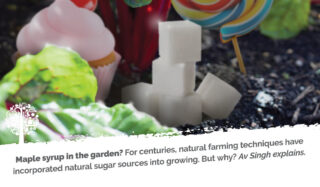Old Wives’ Tale? Bro-Science? Snake Oil? Or Magic Bullet? The use of simple sugars in the garden pre-dates the fancy bottles of “candy” and “sweeteners” that you see lined up in grow shops and garden centers. For hundreds of years, Natural Farming techniques have used honey, molasses, maple syrup, and other natural sugar sources to benefit crop production — but why?
Well, here’s the truth. The truth is — we don’t exactly know why. So many varying factors like soil pH, soil organic matter, and soil microbial life, coupled with our still limited understanding of what actually goes on around the rhizosphere and the root cell membrane, leave us with several potential modes of action of why free sugars benefit plant growth.

Skeptics argue that the whole purpose of photosynthesis is to produce glucose, some of which is used as energy for plant growth, while much of it is exuded into the rhizosphere to feed or attract microbial populations. They contend that supplemental sugars will only attract more microbial species that benefit from an excess of simple sugars and that the practice of sugar supplementation disrupts the natural selection of microbial species that the plant needs; this is true. Exogenous sources of simple sugars will preferentially favor those microbes that see glucose, fructose, and sucrose as food, and their populations will rise as a result. However, recent research reveals that these simple sugars are more than microbial foods.
Most plant physiology textbooks will note that complex organic molecules need to be digested by microbes before being absorbed into the plant. So, essentially, supplemental sugars are not food for plants; they are microbial foods. In contrast, recent research has identified that the relatively impermeable plant cell membrane has Sugar Transport Proteins (STPs), which have a strong affinity for simple sugars and can actively transport them into the plant through roots and other plant organs.
So, what is the benefit of this “free” sugar, considering the plant can already make the stuff? For the longest time, our one-track perception of sugars within the plant was to view them as sources of energy or building blocks for amino acids and other complex molecules. However, sugars play a critical role in modulating plant growth. The simple monosaccharides, sucrose, and glucose, function as signaling molecules that aid the growth and development of plant tissues. This relatively new understanding of the role of sugar in plants can provide added information on the timing of sugar supplementation.
Continually applying “free” sugars to a plant throughout its life cycle may not be the best approach because it will provide significant selection pressure only to allow certain microbial species to thrive. Growers must know that the goal of a healthy soil food web is to have as many actors present on the stage at all times. If concentrated with only bacteria and fungi, nutrients can get tied up and not cycle to the plant. Therefore, sugar supplementation should be strategic and application timings motivated by specific end goals. As with all things in life, moderation is key.

Kickstart Seedling Growth Or Clone Root Development
From the hypocotyl development of the seed to the root extension of your developing clone, exogenous sugars will signal cell elongation and division at the root tip. Both sucrose and glucose have been linked to increased auxin biosynthesis. Auxins are a class of phytohormones that are sugar magnets and are primarily responsible for growth (e.g., the highest concentrations are in the apical and root meristem). Also, a spoonful of sugar helps the mycorrhizae go up. Studies have shown increased mycorrhizal infection rates when soils are supplemented with some fructose.
Crop Steering Using A Little Glucose Boost
Giving your plants a little break from sugars during veg may allow them to establish a more diverse microbial population around the rhizosphere. As a plant is approaching generative growth (flowering), a switch in the form of nitrogen (N) can help maintain optimal plant health and make the transition more fluid. Nitrate (NO3-) is an excellent form of N for growth, but in flowering, plants will be better off with ammonium (NH4+) or amino acids as their source of N. Exogenous glucose has shown to inhibit the uptake of nitrate N and favors the uptake of amino acids like glycine.
Finish With A Sugary Treat For Root Health
A significant hormonal shift happens within a plant in the latter stages of flower or after entering fruit fill. Sugar magnet hormones, auxins, begin to concentrate in flowers and fruits and as a result, so does the majority of photosynthate (i.e., glucose from photosynthesis). Who misses out? The roots. With roots no longer getting their fair share of sugar, root health decreases, and plants become more susceptible to root diseases. Some timely sugar applications in the last couple of weeks before harvest can help stave off root-related plant disease. This late feeding of the rhizosphere can help maintain microbial populations that can continue to produce secondary metabolites like flavonoids, terpenoids, vitamins, and other antioxidants for the developing fruit or flower. Moreover, a little extra post-harvest sugar feeding can provide microbial populations with a much-needed boost for the coming winter when food sources may be slim. The increased activity can help break down potential overwintering sites for pests and pathogens.
This age-old practice works, yet we will continue to better understand why. The one certain truth – the more we know reveals just how little we know about the plant:soil:microbe interface.